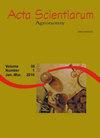巴西塞拉多一种大豆作物上自愿种植玉米的苗期控制和干扰
IF 1.2
4区 农林科学
Q3 AGRONOMY
引用次数: 3
摘要
大豆/玉米的演替已被广泛采用。风暴破坏和作物问题可能导致谷物损失,产生玉米穗碎片甚至整个穗留在土壤中,仍然显示发芽能力,导致自愿植物的出现。在此背景下,本研究旨在评估玉米自愿植株对大豆的干扰,并研究玉米杂交种对孕前除草剂的敏感性。首先进行了玉米种植密度和空间分布对大豆产量影响的试验研究。试验采用随机完全区组设计(RCBD),共4个重复,处理按因子排列(2 × 4) + 1处理。第一个因子对应于玉米植株的空间分布:行或大豆行间;第二个因子采用玉米植株m-2的4个侵染密度:4、8、12和16。附加处理包括不种植玉米植株的对照。第二步,在两个地点进行了一项试验,旨在确定出苗前除草剂对自愿玉米的控制效果。两个实验均在RCBD中进行,分为4个重复。在主要小区评价了氟美沙芬、乳芬、磺苯乙酮、氯脲-乙基、双氯舒仑、氟美舒仑、咪唑乙腈、氯马唑酮、甲曲津、咪唑乙酮+二脲、咪唑乙腈+氟恶嗪和不施用除草剂的对照。在每个小区中,对玉米杂交DKB310 PRO3™和DKB390 PRO3™进行评价。没有观察到自愿玉米的位置对大豆产量的影响。玉米种群的存在导致大豆产量逐步下降,16株m-2的大豆产量下降幅度高达86%。DKB390在使用双氯安定后,林分减少82.88%。双氯sulam对两个杂交品种的玉米植株减少效果较好。本文章由计算机程序翻译,如有差异,请以英文原文为准。
Pre-emergence control and interference of voluntary maize plants on a soybean crop in Brazilian Cerrado
The succession of soybean/maize has been largely adopted. Storm damage and crop problems can lead to grain loss, generating maize ear fragments or even whole ears that remain in the soil and still display germination viability, resulting in the occurrence of volunteer plants. In this context, the present study aimed to evaluate the interference of voluntary maize plants on soybean and investigate the susceptibility of maize hybrids to pre-emergence herbicides. In the first step, an experiment was performed evaluating the influence of voluntary maize plant density and spatial distribution on soybean. The experiment was performed in a randomized completely block design (RCBD) with four replications, with treatments disposed in factorial arrangement (2 x 4) + 1. The first factor corresponded to the spatial distribution of maize plants: row or in between soybean rows; while the second factor adopted four infestation densities of maize plants m-2: 4, 8, 12, and 16. The additional treatment consisted of a control without maize plants. For the second step, an experiment was conducted in two locations aiming to determine the efficacy of pre-emergence herbicides in the control of voluntary maize. Both experiments were installed in RCBD in a split-plot scheme with four replications. Fomesafen, lactofen, sulfentrazone, chlorimuron-ethyl, diclosulam, flumetsulam, imazethapyr, clomazone, metribuzin, [sulfentrazone + diuron], [imazethapyr + flumioxazin], and a control without herbicide application were evaluated in the main plot. In each subplot, the maize hybrids DKB310 PRO3™ and DKB390 PRO3™ were evaluated. No influence on the position of voluntary maize on the soybean yield was observed. The presence of the maize population led to a progressive decrease in soybean yield, ranging up to 86%, at 16 plants m-2. DKB390 displayed a stand reduction of 82.88% after the use of diclosulam. Diclosulam led to better results regarding maize plant decreases for both hybrids.
求助全文
通过发布文献求助,成功后即可免费获取论文全文。
去求助
来源期刊

Acta Scientiarum. Agronomy.
Agricultural and Biological Sciences-Agronomy and Crop Science
CiteScore
2.40
自引率
0.00%
发文量
45
审稿时长
>12 weeks
期刊介绍:
The journal publishes original articles in all areas of Agronomy, including soil sciences, agricultural entomology, soil fertility and manuring, soil physics, physiology of cultivated plants, phytopathology, phyto-health, phytotechny, genesis, morphology and soil classification, management and conservation of soil, integrated management of plant pests, vegetal improvement, agricultural microbiology, agricultural parasitology, production and processing of seeds.
 求助内容:
求助内容: 应助结果提醒方式:
应助结果提醒方式:


